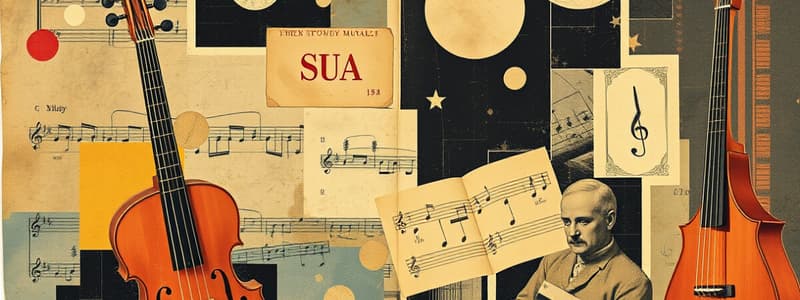Podcast
Questions and Answers
What is Impressionism in music?
What is Impressionism in music?
A movement among composers focusing on suggestion and atmosphere, conveying moods and emotions rather than detailed tone-pictures.
Which of the following are characteristics of Impressionism in music? (Select all that apply)
Which of the following are characteristics of Impressionism in music? (Select all that apply)
- Traditional harmonic progression
- Clear and defined form
- Irregular phrases (correct)
- Whole tone scales (correct)
Who is considered the primary exponent of the Impressionist movement?
Who is considered the primary exponent of the Impressionist movement?
Claude Debussy
What is Expressionism in music?
What is Expressionism in music?
Which composer is credited with the establishment of the twelve-tone system?
Which composer is credited with the establishment of the twelve-tone system?
What are characteristics of Neoclassicism in music? (Select all that apply)
What are characteristics of Neoclassicism in music? (Select all that apply)
Who was the composer known for his innovative style and incorporation of folk materials?
Who was the composer known for his innovative style and incorporation of folk materials?
What is Avant-Garde in music?
What is Avant-Garde in music?
Which composer is known as the 'Father of American Jazz'?
Which composer is known as the 'Father of American Jazz'?
What is Modern Nationalism in music?
What is Modern Nationalism in music?
Which of the following composers was associated with electronic music?
Which of the following composers was associated with electronic music?
What is musique concrete?
What is musique concrete?
Who is known as the 'Father of Electronic Music'?
Who is known as the 'Father of Electronic Music'?
What year was Edgard Varèse born?
What year was Edgard Varèse born?
What is one of Edgard Varèse's notable works?
What is one of Edgard Varèse's notable works?
Who is Karlheinz Stockhausen?
Who is Karlheinz Stockhausen?
Which piece did Karlheinz Stockhausen compose in 1977?
Which piece did Karlheinz Stockhausen compose in 1977?
What unique performance did Stockhausen create involving helicopters?
What unique performance did Stockhausen create involving helicopters?
What is chance music?
What is chance music?
Who is the composer associated with chance music?
Who is the composer associated with chance music?
What is the title of John Cage's famous silent composition?
What is the title of John Cage's famous silent composition?
When was John Cage born?
When was John Cage born?
What is John Cage's view on music?
What is John Cage's view on music?
Flashcards are hidden until you start studying
Study Notes
20th Century Musical Styles: Impressionism to Modern Nationalism
- Impressionism in Music: A late 19th to early 20th-century movement emphasizing mood and atmosphere over detailed representation.
- Characteristics: Includes irregular phrases, avoidance of traditional harmonic progression, ambiguous forms, unresolved dissonances, and use of whole tone scales.
- Claude Debussy: French composer, key figure in Impressionism (1862-1918) known for works like "Claire de Lune" and "La Mer". His innovative approach redefined musical harmony and form.
- Maurice Ravel: Notable Impressionist composer (1875-1937) known for "Bolero" and "Pavane for a Dead Princess". Ravel's style was innovative, focusing on unique harmonic treatment without atonality.
Expressionism and its Composers
- Expressionism in Music: Represents the inner thoughts of composers using atonality and twelve-tone scales, expressing emotions like anxiety and alienation.
- Characteristics: Features episodic structures, abrupt language, dissonances, and high emotional intensity.
- Arnold Schoenberg: Viennese composer (1874-1951), known for establishing the twelve-tone technique. Key works include "Pierrot Lunaire" and "Verklärung der Nacht".
- Igor Stravinsky: Russian composer (1882-1971) influenced by Nikolai Rimsky-Korsakov, famous for the groundbreaking ballet "The Rite of Spring" (1913).
Neoclassicism in Music
- Neoclassicism: A 20th-century trend focusing on clarity, balance, and emotional restraint, typically reviving older forms and styles.
- Characteristics: Emphasizes clear themes, revives classical forms, and merges traditional elements with modern ones.
- Béla Bartók: Hungarian composer (1881-1945), known for integrating folk elements into classical music. Notable works include "Concerto for Orchestra" and "Mikrokosmos".
Avant-Garde and Significant Figures
- Avant-Garde in Music: Represents innovative music embracing experimentation, often rejecting traditional forms and introducing elements like improvisation and technology.
- George Gershwin: American composer (1898-1937) known for blending classical and jazz influences. Famous for "Rhapsody in Blue" and "An American in Paris".
- Leonard Bernstein: Composer and conductor (1918-1990) recognized for his work in Broadway and classical music, known for "West Side Story" and "Candide".
Modern Nationalism in Music
- Modern Nationalism: A musical trend of the 20th century blending modern techniques with folk music, expressing national identity.
- Sergei Prokofiev: Russian composer (1891-1953) who wrote across various genres, including ballet and film music, recognized for works like "Visions Fugitive".
Electronic Music and Chance Music
- Electronic Music: Utilizes electronic instruments like synthesizers and tape recorders to create sound, exemplified by musique concrète, which manipulates real-life sounds.
- Edgard Varèse: Innovator in electronic music (1883-1965), known for his abstract sound compositions. Significant works include "Poème Électronique" and "Ionisation".
- Karlheinz Stockhausen: Central figure in electronic music (1928-2007), noted for his avant-garde, atonal works which pushed traditional boundaries.
Summary
- The 20th century witnessed diverse musical styles, including Impressionism, Expressionism, Neoclassicism, Avant-Garde, and Modern Nationalism, each contributing unique perspectives on sound, emotion, and culture in music.### Karlheinz Stockhausen (1928–2007)
- Influential composer in electronic and musique concrète music.
- Known for innovative works, such as Gruppen (1957), which features three orchestras with spatial and temporal dynamics.
- Created Kontakte (1960), emphasizing the capabilities of tape machines.
- Composed Hymnen (1965), a lengthy two-hour piece structured around 40 juxtaposed musical elements.
- Announced Licht (Light) in 1977, a monumental seven-part opera corresponding to the days of the week with a vast ensemble of singers, dancers, and electronic elements.
- Developed Helicopter String Quartet, where musicians perform in four helicopters, showcasing his interest in music's spatial characteristics.
- Envisioned concert halls designed to engage listeners with sound from multiple directions.
John Cage (1912–1992)
- Born in Los Angeles, recognized as a groundbreaking composer in Western music.
- Known for redefining music through experimental techniques and unconventional uses of instruments.
- Pioneered chance music, where performances differ due to randomness in production techniques and environmental sounds.
- Composed Music of Changes (1951) for piano, heavily influenced by Zen Buddhism and chance operations.
- Gained fame with Four Minutes and 33 Seconds (4'33"), a composition instructing silence but emphasizing ambient sounds.
- Integrated real-world experiences into performances, exemplified by a piece requiring him to cook mushrooms on stage for sound exploration.
- Influential in shaping modern music since the 1950s and regarded more as a philosopher than a traditional composer.
- Authored many writings on music, delivering his ideas with humor and intellect.
- Contributed to various artistic fields, including dance and musical theater, with a portfolio of around 229 compositions.
Studying That Suits You
Use AI to generate personalized quizzes and flashcards to suit your learning preferences.




